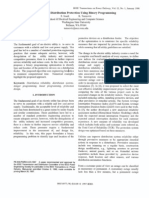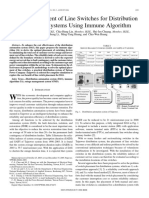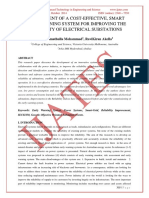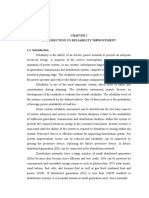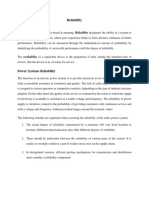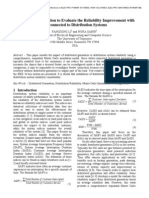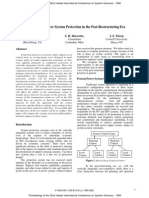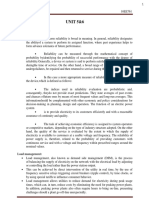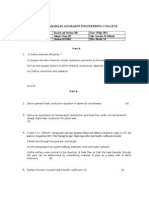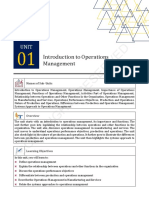Issues of Reliability and Security in Distributed Autonomous Power Systems
Issues of Reliability and Security in Distributed Autonomous Power Systems
Uploaded by
Harjit Singh MangatCopyright:
Available Formats
Issues of Reliability and Security in Distributed Autonomous Power Systems
Issues of Reliability and Security in Distributed Autonomous Power Systems
Uploaded by
Harjit Singh MangatOriginal Title
Copyright
Available Formats
Share this document
Did you find this document useful?
Is this content inappropriate?
Copyright:
Available Formats
Issues of Reliability and Security in Distributed Autonomous Power Systems
Issues of Reliability and Security in Distributed Autonomous Power Systems
Uploaded by
Harjit Singh MangatCopyright:
Available Formats
Issues of Reliability and Security in Distributed Autonomous Power Systems
Kevin Tomsovic PO Box 642752 School of Electrical Engineering and Computer Science Washington State University Pullman, WA 99164-2752
1. Introduction
The concept of a distributed autonomous power system (DAPS) composed of several loosely connected autonomous power systems (APS) has been proposed. In this system, generator units will be responsible for nearby load and independently dispatched but still dependent on outside sources for normal operation. DAPS is being driven both by regulatory developments and technology improvements. Regulatory changes stem from a desire to introduce competition into the delivery of electric service and in turn to create new and better services. New services will include time-of-use pricing, location and price dependent reliability, maintenance functions and reserve supplies. Technology developments include both generation and storage technology microturbines, fuel cells, power electronics, batteries, flywheels, etc. as well as, information and communication systems, which allow greater customer control and the diversification of services. Each APS may be characterized by different capacities, independence of operation and quality of service. For example, a residential community may desire a low capacity system with relatively frequent interruptions at a low cost. The currently available analysis tools provide no good methods for understanding the operation of such systems.
As such, this paper poses some important problems in the evaluation and design for reliability of a DAPS. The emphasis here is on the performance measures although
clearly the end concern is the appropriate algorithms, or intelligence, for the distributed subsystems to be operated effectively as a whole. To narrow the discussion, the interconnected subsystems will be considered primarily radial in structure, that is, similar to the traditional distribution system, only with multiple sources. As such, discussion begins from traditional distribution system reliability analysis. Note in the extant power system, distribution circuits contribute over 90% towards customer outage and supply unavailability [Alla79]. The wide exposure to harsh elements and the radial structure design, which accepts single point failures for lower cost, leads to this result. The expectation is that DAPS could greatly improve this performance under appropriate operation of the various subsystems. In the following, a general discussion of distribution system reliability leads to the posing of several important research questions.
2. Revisiting Distribution System Reliability
Power system reliability can be classified into two components: security and adequacy [Bill84]. Adequacy is the static evaluation of a systems ability to supply the load. Security refers to the systems capability to experience contingencies (outages) and maintain service to all customers and respect all equipment limits. Traditionally, these have been analyzed as separate issues and it is quite possible to have a reliable but insecure system (say, in a system where critical contingencies are numerous but occur rarely) and vice versa. In general, adequacy is focused on planning while security is
focused on operations. In the traditional distribution system, the security problem is not meaningful. That is in a single source radial system, any outage will result in customer interruptions and is thus, by the traditional definitions, insecure. In the DAPS architecture, security enters distribution systems analysis for the first time. Note,
reliability assessment overlaps with measures of power quality. Such power quality concerns, while particularly important in a DAPS, are beyond the scope of this white paper. In the following, several areas in need of further research to design a reliable system are identified.
2.1 Distribution System Adequacy
A variety of reliability indices for a distribution system have been defined [IEEE96]. These indices can be divided into three categories: single load point indices, customer orientated indices, and load orientated indices. Single load point indices, which provide service reliability data from an individual customer viewpoint, are the average failure rate ls ,
l s = li
i =1
(1)
the average outage duration rs ,
rs =
l r
i i =1 n
l
i =1
(2)
and the average annual outage duration U s , U s = li ri
i =1 n
(3)
where n is the set of components whose failure results in an outage at the given load point s, li is the failure rate of component i and ri is the outage time of component i. A recent survey [Warr91] indicates that the majority of the utilities use customer based indices to evaluate their service reliability, with the most commonly used indices given as System Average Interruption Frequency Index (SAIFI), System Average Interruption Duration Index (SAIDI), Customer Average Interruption Duration Index (CAIDI), Average Service Availability Index (ASAI) and Momentary Average Interruption Frequency Index (MAIFI). The SAIFI index, given here for reference, is SAIFI =
l N
i
NT
(4)
where Ni is the number of customers in section i and NT is the total number of customers on the feeder. Load orientated indices, such as as Average System Interruption Frequency Index (ASIFI) and Average System Interruption Duration Index (ASIDI), are similar except the number of customers replaced by the connected MW load.
Protection systems Protective devices play a fundamental role in improving distribution system reliability. Automatic line sectionalizing devices such as line reclosers, interrupters, sectionalizers and fuses will reduce the total number of customers affected for a single outage by automatically isolating the faulted section. They also reduce the frequency of outages for customers on the source side of these devices, and reduce the duration of outages by expediting the task of locating the faulted feeder section. In theory, the more automatic devices installed on a distribution feeder the better the service reliability. Still, 4
there are some application limitations, such as, coordination between devices and the cost of the installation, maintenance and operation. Also, three phase line sectionalizing devices with automatic reclosing capabilities may worsen the MAIFI index. Manual line sectionalizing devices, such as switches and disconnects, will reduce the duration of interruption by allowing faulted line sections to be manually isolated and permit service to be restored to customers on unfaulted sections of the feeder. The addition of manually operated line sectionalizing devices reduces the average annual customer minute outages but they do not have an affect on outage frequency. Remote controlled sectionalizing devices will allow a system operator, or automatic restoration program, to identify a faulted section and remotely operate certain switches to restore service to customers, further reducing the average annual customer minutes of outages but not affecting the outage frequency. A formulation for optimizing the use of all types of protective devices is discussed in the next section. The inclusion of multiple sources via dispersed generation units requires some modification to the above discussion. Assuming islanding (disconnected subsystems operating with a balance of load and generation) is feasible, the number of failures that will result in an outage for a customer can be greatly reduced. The single load point indices given by (1)-(3) (i.e., ls , rs , and U s ) must be appropriately recalculated by determining the impact on every customer. The impact will depend on the nature of the islanding scheme (including the possibility of a momentary interruptions) and the performance of the islanded subsystem. The islanded subsystem may also exhibit some form of degraded performance, such as less stable frequency. Clearly, the computation of these indices, as well as the customer or load orientated indices, is now more problematic. 5
Further, the SAIFI index (as well as most of the reliability indices) may be completely inappropriate as it fails to distinguish between customer types in assessing the performance. Automatic sectionalizing switches, and to a lesser extent fuses, will now serve to isolate not only source-side customers but potentially downstream customers as well. The effectiveness of each protective device has increased only if proper coordination can be maintained. So, islanding will greatly complicate two other areas of concern for protection engineers: the coordination of devices for proper selectivity, and the design of automatic reclosing operations when downstream load is energized but not synchronized. In summary, the primary problems of concern in protection design are then P1: Development of new measures appropriate for system reliability in a DAPS that can aid overall protective system design. P2: Development of short-circuit algorithms for radial systems with multiple sources coupled with appropriate techniques for reclosing operations to temporarily island and subsequently restore subsystems.
System maintenance The utility industry takes various preventive actions to minimize component failure rates, which have a direct impact on service reliability. The preventive actions at the distribution level consist of routine maintenance on testable and repairable components, replacement of none repairable components, tree trimming, installation of animal guards and washing of insulators. The maintenance actions can be considered to be the general monitoring, testing, and repairing of components that deteriorate due to aging and continuous operation. Traditionally, most utilities followed a rigid maintenance schedule based either on a fixed time interval, or on the number operations for the 6
equipment, or on a combination of both. Routine maintenance based on a fixed time schedule depends on the individual utility practices or the manufacturer's
recommendations. Non-repairable equipment will be replaced if it fails, or as it ages, if the expected failure rate exceeds an unacceptable value. Today, due to increased economic pressures, utilities have been forced to reduce operation and maintenance costs. Thus, there is a need to perform maintenance at minimum cost without jeopardizing system reliability. One of the techniques has been to increase the time interval for routine protective device routine maintenance and testing. Self-diagnostic capability of new protective devices contributed to the justification for this increase in the maintenance interval [Alex94,Kumm93,Kumm95]. Following cost savings achieved in the aircraft industry, utilities have considered the concept of Reliability Centered Maintenance (RCM). RCM views all maintenance from a system reliability point of view, so that, for example, non-critical equipment may receive no preventive maintenance, some equipment is maintained at regular intervals and critical equipment is maintained based on on-line monitoring. In the power industry, most efforts have focused on data gathering and the application of reliability measures has been heuristic [Endr97]. Reliability analyses have been developed which calculate the contribution of each line section, and its associated equipment, to the overall reliability indices [Gold87]. Such data assists engineers in evaluating the impact of various proposed maintenance schedules. A minimum preventive maintenance model has been built for repairable devices whose condition deteriorates with time in service [Sim88]. The authors' work has sought to add rigor to these techniques. 7
It is important to note that the effectiveness of a maintenance program depends fundamentally on the protection scheme. Similar to the formulation for protection system design, a binary linear program to optimize maintenance resources has been proposed by the author [Soud97a]. The objective is to focus attention on the more critical components. The method will identify where resources should be allocated in order to achieve the maximum benefit. While there has been inadequate understanding of RCM methods for power distribution systems under the current structure, numerous complications arise in a distributed system. To begin, each of the subsystems may have different ownership. Maintenance that may be beneficial for the system may not be cost effective for a subsystem. There must be economic motivation to ensure cooperation among the subsystems. The regulatory framework should establish market mechanisms to ensure adequate maintenance of the system infrastructure. For example, there may be no economic motivation to perform proper maintenance on the interconnections between the subsystems, if windfall profits can be realized on subsystems that become islanded. An important area for investigation will be P3: Development of methods for assessing maintenance needs to meet reliability targets determined by the market mechanisms while ensuring adequate infrastructure. Value of reliability and other market considerations There have been numerous studies for predicting the cost/benefit ratio associated with distribution feeder reliability [Goel94, Hort89]. The interruption energy assessment rate (IEAR) links customer outage cost to the service reliability indices in order to incorporate such costs in the reliability cost/benefit formulation [Goel91]. In [Brow96], a 8
new measure of reliability was developed which includes both utility and customer costs referred to as the Total Cost of Reliability (TCR). The protection system design in that work was optimized based on TCR. In a deregulated system, the market will determine the value of reliability. Still, the operation of each subsystem and the rules for cooperation among subsystems require guidelines in order to achieve reliable and cost effective designs. The value of reliability may turn out to be a complex and dynamic function of load level, customer type, outage history in a region, and so on. Accurate load forecasts for the demand area for the APS must be coordinated with the system load forecasts which in turn must be coupled with the concern for reliability. A fundamental research problem in order to design cost effective systems is then P4: Investigating the value of reliability and the demand characteristics in a market driven system realizing that these may be highly dependent on the specific customer, the time, the location and the outage history.
2.2 Distribution System Security
Security in a DAPS will depend on the ability of an islanded system to supply load. One anticipates that dispersed generation and storage may be of adequate capacity to supply a significant part of the load in an area for at least a short amount of time. In concept, a radial distributed system could be envisioned that is fully secure with respect to all likely single and multiple contingencies. Still, it seems clear that a more useful vision of security will be from a customer viewpoint rather than a system viewpoint. A security index for each customer would depend on the specific service connection. In a simple way, indices similar to adequacy could be defined. For example, consider a static security rate l s , defined as 9
l s =
1 n Pi n i =1 Pi max
(5)
where Pi is the loading on a section i, Pimax is the maximum load allowable for that section, and component i is a critical component supplying load point s. Similarly, a static system security index (SSSI) could be determined as SSSI =
l N
i
NT
(6)
A different level of security could characterize each load point, i.e., customer. The author is deliberately proposing a security index that is similar to the customer orientated adequacy indices. Security will be of unquestionable importance but must be considered integral to reliability to be meaningful for most customers. Even more difficult is the problem of dynamic security. Dynamic security is traditionally concerned with maintaining stability, i.e., synchronism, of all generating units with respect to a specified set of contingencies. A distributed system with small units and islanding capabilities may have an extremely large number of units that cannot withstand certain transient events but whose separation will not impact service. A distributed system could be designed that could survive a large number of unstable events. Thus, we have identified two very broad areas that require further investigation P5: Development of new measures of static security for DAPS. P6: Development of new measures of dynamic security for DAPS.
2.3 Distribution Intelligent Systems for Reliable Performance
The above areas of concern focus on development of new measures of reliability
10
and new tools for designing systems based on these measures; however, there is an overriding difference in design process that cannot be neglected. The APS are not only independent in terms of operation but also in terms of the business ownership. There will be a significant barrier to optimizing the performance if interests conflict among owners of the subsystems. Information necessary to optimize the overall reliability may not be freely shared. The question arises as to what decisions can be made on the basis of local information. For example, the decision to maintain a unit in one area clearly depends on the condition of equipment in nearby areas. As another example, a controller that normally provides effective stabilization for some unit may be ineffective if another unit responds in a manner that reduces overall system damping. While each subsystem will necessarily operate under greater uncertainty, there must be guidelines to ensure adequate information to sustain a functioning system. In such an uncertain environment, it is doubtful traditional algorithms for design, operation and control will be adequate. Systems are needed that can observe system operation, determine the current mode of operation and subsequently select appropriate algorithms. This includes systems that will respond to market data as well as physical system parameters. In this vein, the author has investigated fuzzy logic stabilization control and analyzed stability in terms of general rule structure descriptions of systems rather than precise analytical models [Hoan96,Toms97]. This model allows stability analysis to proceed even under very limited information. In addition, the author has used fuzzy information techniques to perform condition monitoring and maintenance given limited and approximate information [Toms93,Toms96]. 11
In general, an important area for investigation will be P7: Development of decentralized intelligent decision aids for design and operation that are robust in the face of limited and uncertain information.
3. Some Results in Optimizing Distribution System Reliability
As seen in the above, the number, type and location of the protective devices on a distribution feeder have a direct effect on the reliability. In [Soud98a], a technique was proposed to identify the number, type and location of the protective devices in order to minimize the SAIFI index. In [Soud97b], a proposed technique identifies type of the protective devices at the predetermined locations on a distribution feeder based on the objective of minimizing reliability indices, such as SAIFI, ASIFI, or by minimizing cost while achieving desired performance levels. The developed objective function for SAIFI is listed here for discussion purposes A q = lqi + g qi
i =1 qn
) N - g
qn qn j =i qj i =1 qn i -1 i =2 j =1
qi
xqi 2 N qj +
j =i qn
qn
l N x
i =2 qi j =1 qj k = j +1 i qk ql 1 ql 2
qn
i -1
qk 1 qk 2
g qi 1 - xqj 2
) N x
k= j l = j +1
(7)
where qn is the number of the possible locations on the main feeder or lateral, l qi is the permanent failure rate and g qi is the temporary failure rate for section i of q, respectively, and N qj is the number of customers for section j of q including all laterals connected to that section. Note, if there is a three phase device at location qk, then the variable
xqk1 = 0 , and otherwise xqk1 = 1 . Here, the subscript 1 is used to represent a three phase
device and the subscript 2 represents a fuse. These counter intuitive definitions for the 12
variables x are used to simplify equation (7). Minimizing
for all circuit branches
will minimize the SAIFI index. The above objective function is complex due to the multiple interactions among the protective devices. Still, it has been shown to be tractable for practical problems. To solve this system, the distribution feeder is divided into four categories: a main feeder, lateral one, lateral two or lateral three. A lateral one category is short and will not be fused. The effect of this lateral on reliability can be included in the feeder section from which it branches. A lateral two will only be fused and its effect on the SAIFI index is constant. All other laterals are category three. Thus, only the main feeder and category three laterals are explicit in the optimization. The constraints for this problem include those on coordination, number of devices, economic cost, and various other design parameters. In addition, there are constraints due to the reduction of the integer programming problem to zero-one linear programming problem. These are detailed in reference [Soud98a]. This work was extended in [Soud98b] by using a goal programming approach to optimize the effectiveness of protective devices. The goals are: a) to minimize the SAIFI and ASIFI indices by identifying types and locations of protective devices and b) to achieve a reasonable trade-off between a decrease in the SAIFI index and an increase in the MAIFI index by identifying where a fuse saving scheme should be applied. The solution is shown to be a Pareto optimal over the various objectives. The majority of faults on a distribution circuit are momentary. The effect of momentary faults on customers will depend on the type of the protective device. Customers within the reach of an automatic protective device will have a momentary 13
outage with the outage duration dependent on the recloser timing. Customers on a fused lateral may experience a permanent outage unless a fuse saving scheme is applied. With a fuse saving scheme, an automatic device clears all temporary faults but a fuse clears permanent faults. Thus, the cost of applying a fuse saving scheme is that the number of momentary outages will increase [Soud97a]. These formulations are extendable to the DAPS architecture. Clearly as the
impact of an outage changes due to the possibility of islanding, the objective function of (7) must be modified appropriately and as the definitions of reliability evolve they must be incorporated into the design decisions. Further, the design is not merely for the placement and reach of protective devices but also the reach of each subystem. That is, the optimal size of a subsystem to achieve reliable performance. Still the structure of this optimization shall be fundamentally the same. Placement of protective devices and subsystem boundaries must be carefully designed to achieve cost effective and reliable performance. The author proposes to study the P8: Extension of the optimization of protective device type and location for reliability to a DAPS so as to include not only the device layout but also the boundaries among subsystems.
4. Summary of Research Issues
This white paper has identified several research issues in the design of reliable DAPS. These research issues are repeated here for convenience P1: Development of new measures appropriate for system reliability in a DAPS that can aid overall protective system design. P2: Development of short-circuit algorithms for radial systems with multiple sources coupled with appropriate techniques for reclosing operations to 14
temporarily island and subsequently restore subsystems. P3: Development of methods for assessing maintenance needs to meet reliability targets determined by the market mechanisms while ensuring adequate infrastructure. P4: Investigating the value of reliability and the demand characteristics in a market driven system realizing that these may be highly dependent on the specific customer, the time, the location and the outage history. P5: Development of new measures of static security for DAPS. P6: Development of new measures of dynamic security for DAPS. P7: Development of decentralized intelligent decision aids for design and operation that are robust in the face of limited and uncertain information. P8: Extension of the optimization of protective device type and location for reliability to a DAPS so as to include not only the device layout but also the boundaries among subsystems.
The authors work has been placed in the context of these research issues. The research directions represent a variety of difficult engineering issues complicated by new regulatory structures that will most likely encourage competition over cooperation. Still, these areas can be tied together by each the participants desire to improve overall reliable performance despite the relative independence of the subsystems. The eventual success of the DAPS architecture may well be determined more by the system reliability than the economic costs.
5. References
[Alex94] G.E. Alexander, Developing a Philosophy for Testing of Digital Protective Relaying Schemes, Proceedings of the 21st Annual Western Protective Relay Conference, Spokane, Washington, October 18-20, 1994. R.N. Allan and E.N. Dialynas, I.R. Homer, Modeling and Evaluating the Reliability of Distribution Systems, IEEE Transactions on Power 15
[Alla79]
Apparatus Systems, Vol.PAS-98, No. 2, Nov./Dec. 1979, pp.436-444. [Bill84] R. Billinton and R.N. Allan, Reliability Evaluation of Power Systems, New York: Plenum Press, 1984, pp. 210-239. R.E. Brown, Reliability Assessment and Design Optimization in Electric Power Distribution Systems, Ph.D. Dissertation, University of Washington, 1996. J. Endrenyi, G.L. Anders and A.M. Leite da Silva, Probabilistic Evaluation of the Effect of Maintenance on Reliability - An Application, IEEE Transactions on Power Systems, in press. L.Goel and R.N. Allan, Evaluation of Interrupted Energy Assessment Rates in Distribution System, IEEE Transactions on Power Systems, Vol. 6, No. 4, Oct. 1991, pp. 1876-1882. L. Goel and R. Billinton, Determination of Reliability Worth for Distribution System Planning, IEEE Transactions on Power Delivery, Vol. 9, No. 3, July 1994, pp. 1577-1583. W.F. Horton, S. Goldberg and R.A. Hartwell, A Cost/Benefit Analysis in Feeder Reliability Studies, IEEE Transactions on Power Systems, Vol.4, No.1, Jan. 1989, pp. 446-452. P. Hoang and K. Tomsovic, Design and Evaluation of an Adaptive Fuzzy Power System Stabilizer, IEEE Transactions on Energy Conversion, Vol. 11, No. 2, June 1996, pp. 455-461. IEEE Working Group on System Design, Trial Use Guide for Electric Power Distribution Reliability Indices, Report p1366, Draft #14. J.J. Kumm, M.S. Weber, E.O. Schweitzer, III and D. Hou, Philosophies For Testing Protective Relays, Proceedings of the 20th Annual Western Protective Relay Conference, Spokane, Washington, October 19-21, 1993.
[Brow96]
[Endr97]
[Goel91]
[Goel94]
[Hort89]
[Hoan96]
[IEEE96]
[Kumm93]
[Kumm95] J.J. Kumm, D. Hou, E.O. Schweitzer, Predicting the Optimum Routine Test Interval For Protective Relays, IEEE Transactions on Power Delivery, Vol. 10, No. 2, April 1995, pp. 659-665. [Soud97a] F. Soudi, Towards Optimized Protection Design and Maintenance in Electric Power Distribution Systems, Ph.D. Dissertation, Washington State University, June 1997. F. Soudi and K. Tomsovic, Towards Optimized Distribution Protection 16
[Soud97b]
Design, Proceedings of the Third International Conference on Power System Planning and Operations, Abidjan, Cote d'Ivoire, Jan. 1997, pp. 354-358. [Soud98a] F. Soudi and K. Tomsovic, Optimized Distribution Protection Using Binary Programming, IEEE Transactions on Power Delivery, Vol. 13, No. 1, Jan. 1998, pp. 218-224. F. Soudi and K. Tomsovic, Optimal Trade-Offs in Distribution Protection Design, submitted to IEEE Transactions on Power Delivery. K. Tomsovic, M. Tapper and T. Ingvarsson, A Fuzzy Information Approach to Integrating Different Transformer Diagnostic Methods," IEEE Transactions on Power Delivery, Vol. 8, No. 3, July 1993, pp. 1638-1646. K. Tomsovic and B. Baer, Methods of Approximate Reasoning for Power System Reliability Analysis," Australian Journal of Intelligent Information Processing Systems, Vol. 3, No. 1, Autumn 1996, pp. 23-31. K. Tomsovic, Stability Analysis Methods of Fuzzy Logic Controls for Power Systems, Proceedings of the 1997 International Conference on Intelligent System Applications to Power Systems, Seoul, Korea, July 6-10, 1997, pp. 104-108. C.M. Warren, The Effect of Reducing Momentary Outages on Distribution Reliability Indices, Proceedings of the 1991 IEEE T&D Conference, Dallas, Texas, Sept. 22-27 1991, pp. 698-703.
[Soud98b]
[Toms93]
[Toms96]
[Toms97]
[Warr91]
17
You might also like
- Barrett Brown Overview of The Strategist Alchemist Ironist Action LogicsDocument16 pagesBarrett Brown Overview of The Strategist Alchemist Ironist Action Logicsgabriela100% (1)
- Reliability Analysis of Distribution SystemDocument13 pagesReliability Analysis of Distribution Systemjagadeeshkumar116No ratings yet
- Power System Reliability Questions-1-4Document3 pagesPower System Reliability Questions-1-4Kashaf ShahidNo ratings yet
- Ptimized Distribution Protection Using Binary Programming: 218 Ieee Vol. 13, 1998Document7 pagesPtimized Distribution Protection Using Binary Programming: 218 Ieee Vol. 13, 1998David PerezNo ratings yet
- Ecost PDFDocument6 pagesEcost PDFThúy Mai Thị ThanhNo ratings yet
- Heuristic Approach To Ring Main Unit Placement Within A Self-Healing Distribution NetworkDocument6 pagesHeuristic Approach To Ring Main Unit Placement Within A Self-Healing Distribution NetworkMERYAM MAZINNo ratings yet
- Internet of EverthingDocument25 pagesInternet of EverthingPyusNo ratings yet
- Optimal Recloser Setting, Considering Reliability and Power Quality in Distribution NetworksDocument7 pagesOptimal Recloser Setting, Considering Reliability and Power Quality in Distribution NetworksNassar AbdulrahimanNo ratings yet
- Saidi SaifiDocument8 pagesSaidi SaifiLittle Trees BorneoNo ratings yet
- Overview Theory of Reliability in Distribution SystemDocument7 pagesOverview Theory of Reliability in Distribution SystemMoe Thant OoNo ratings yet
- Reliability Analyses of Electrical Distribution System: A Case StudyDocument9 pagesReliability Analyses of Electrical Distribution System: A Case StudyHddjdjNo ratings yet
- Colocación Óptima de Interruptores de Línea para Sistemas de AutomatizaciónDocument9 pagesColocación Óptima de Interruptores de Línea para Sistemas de AutomatizaciónAlee Re LxuNo ratings yet
- Assessment of Reliability in Power Distribution SystemDocument8 pagesAssessment of Reliability in Power Distribution Systembudi hermawanNo ratings yet
- Unit 2Document50 pagesUnit 2habte gebreial shrashrNo ratings yet
- Optimal Electric Power Distribution System Reliability Indices Using Binary Programming.Document6 pagesOptimal Electric Power Distribution System Reliability Indices Using Binary Programming.hanabishimanNo ratings yet
- Unit 2Document46 pagesUnit 2habte gebreial shrashrNo ratings yet
- Midterm Exam Ee Electives Ramos Alyssa Maren PipoDocument2 pagesMidterm Exam Ee Electives Ramos Alyssa Maren PipoAlyssa RamosNo ratings yet
- ModuleDocument52 pagesModuleAbdalla ElsayedNo ratings yet
- b5 Special Report 2012Document14 pagesb5 Special Report 2012raghavendran raghuNo ratings yet
- FLISRDocument13 pagesFLISRbayuNo ratings yet
- 01 - Overview of Protection FundamentalsDocument28 pages01 - Overview of Protection FundamentalsM Kumar MarimuthuNo ratings yet
- CH 4Document30 pagesCH 4Moe Thant OoNo ratings yet
- PQ Contracts in A Competitive Electric Utility Industry - M McGranahan Et AlDocument6 pagesPQ Contracts in A Competitive Electric Utility Industry - M McGranahan Et AlÓscar GuerraNo ratings yet
- Study Committee B5 Colloquium 2007 October 15-20 Madrid, SPAINDocument13 pagesStudy Committee B5 Colloquium 2007 October 15-20 Madrid, SPAINraghavendran raghuNo ratings yet
- AnOverviewofAutomationinDistributionSystemsDocument13 pagesAnOverviewofAutomationinDistributionSystemsDaniel RodríguezNo ratings yet
- Revisao ArtigosDocument2 pagesRevisao ArtigosBrian JaramilloNo ratings yet
- Development of A Cost-Effective, Smart Early Warning System For Improving The Reliability of Electrical SubstationsDocument5 pagesDevelopment of A Cost-Effective, Smart Early Warning System For Improving The Reliability of Electrical Substationsmayalasan1No ratings yet
- Effects of Integration of Distributed Generation On Reliability in Distribution SystemDocument8 pagesEffects of Integration of Distributed Generation On Reliability in Distribution SystemInternational Journal of Power Electronics and Drive SystemsNo ratings yet
- Distribution System ReliabilityDocument38 pagesDistribution System Reliabilitymark ianNo ratings yet
- Introduction To Reliability ImprovementDocument2 pagesIntroduction To Reliability ImprovementMoe Thant OoNo ratings yet
- Power System Reliability Assessment: Keynote Address OnDocument61 pagesPower System Reliability Assessment: Keynote Address OnkuncoroNo ratings yet
- Publication Distribution System Security and PlanningDocument23 pagesPublication Distribution System Security and PlanningmohsinamanNo ratings yet
- The Role of Protection Performance Audits in The Lifetime Management of Protection SystemsDocument10 pagesThe Role of Protection Performance Audits in The Lifetime Management of Protection Systemssno-koneNo ratings yet
- Predictive Maintenance Strategy Based On Disturbance RecordersDocument7 pagesPredictive Maintenance Strategy Based On Disturbance Recordersintiw_23No ratings yet
- 4 PDFDocument8 pages4 PDFHabibe DJOMAKONNo ratings yet
- Distribution Management SystemDocument7 pagesDistribution Management Systemg tsNo ratings yet
- Discussions and Conclusion 6.1. DiscussionsDocument2 pagesDiscussions and Conclusion 6.1. DiscussionsMoe Thant OoNo ratings yet
- Activity 10-1Document4 pagesActivity 10-1therealtristesseNo ratings yet
- Smart Grid Fault Location, Isolation, and Service Restoration (FLISR) Solutions To Manage Operational and Capital ExpendituresDocument6 pagesSmart Grid Fault Location, Isolation, and Service Restoration (FLISR) Solutions To Manage Operational and Capital ExpendituresbaoHVLABNo ratings yet
- Monte Carlo Simulation To Evaluate The Reliability Improvement With DG Connected To Distribution SystemsDocument6 pagesMonte Carlo Simulation To Evaluate The Reliability Improvement With DG Connected To Distribution SystemsbemzbemNo ratings yet
- Reliability Assessment of Distribution System With Distributed GenerationDocument7 pagesReliability Assessment of Distribution System With Distributed Generationitsnaga23No ratings yet
- State-Of-The-Art FLISR For Enhanced Power Distribution ReliabilityDocument9 pagesState-Of-The-Art FLISR For Enhanced Power Distribution Reliabilityroyyan fadhillahNo ratings yet
- Ect 148Document20 pagesEct 148Aceel FitchNo ratings yet
- Coordination of Relays, Reclosers, and Sectionalizing Fuses For Overhead Lines in The Oil PatchDocument8 pagesCoordination of Relays, Reclosers, and Sectionalizing Fuses For Overhead Lines in The Oil PatchluhusapaNo ratings yet
- Evaluating Quality of Service and Behavioral Reliability of Steer-by-Wire SystemsDocument8 pagesEvaluating Quality of Service and Behavioral Reliability of Steer-by-Wire SystemsAbdurahman DwijotomoNo ratings yet
- Distribution System Reliability IndicesDocument7 pagesDistribution System Reliability Indicesabera alemayehuNo ratings yet
- Kumar 2018Document24 pagesKumar 2018kena2No ratings yet
- Planning and The Operation of Renewable Powered GridDocument3 pagesPlanning and The Operation of Renewable Powered GridAniruddha BehereNo ratings yet
- Embedded Generation and Evaluation Technique: System Operating and Outage DataDocument13 pagesEmbedded Generation and Evaluation Technique: System Operating and Outage DataMoe Thant OoNo ratings yet
- Reliability Evaluation of DG Integrated Automated Distribution SystemDocument6 pagesReliability Evaluation of DG Integrated Automated Distribution SystemhanabishimanNo ratings yet
- Aspects of Power System Protection in The Post-Restructuring EraDocument7 pagesAspects of Power System Protection in The Post-Restructuring ErakhkamalNo ratings yet
- Object XMLDocumentDocument9 pagesObject XMLDocumentkhoshnamaNo ratings yet
- Reliability 2022 FinalDocument30 pagesReliability 2022 FinalMohamed ElzabalawyNo ratings yet
- Asset ManagementDocument4 pagesAsset ManagementJohan TadlasNo ratings yet
- Paper For Research Topic MS StduentsDocument29 pagesPaper For Research Topic MS StduentsSaifullah Gul muhammadNo ratings yet
- Protection SettingsDocument33 pagesProtection SettingsirfanWPK100% (1)
- UNIT 5&6: Power Supply ReliabilityDocument5 pagesUNIT 5&6: Power Supply ReliabilityHiteshNo ratings yet
- Safety ................................................................................................................................... 1Document19 pagesSafety ................................................................................................................................... 1Harjit Singh MangatNo ratings yet
- Powermos Transistor Buk200-50Y Topfet High Side Switch: Description Quick Reference DataDocument13 pagesPowermos Transistor Buk200-50Y Topfet High Side Switch: Description Quick Reference DataHarjit Singh MangatNo ratings yet
- Information Paper: Northern Territory Skilled Occupation Priority ListDocument10 pagesInformation Paper: Northern Territory Skilled Occupation Priority ListHarjit Singh MangatNo ratings yet
- EG 341 SyllabusDocument5 pagesEG 341 SyllabusHarjit Singh MangatNo ratings yet
- Course Objectives and OutcomesDocument2 pagesCourse Objectives and OutcomesHarjit Singh MangatNo ratings yet
- SessionalDocument2 pagesSessionalHarjit Singh MangatNo ratings yet
- Nishii Paluch 2018 HRMRDocument5 pagesNishii Paluch 2018 HRMRzhaoshuangzhu888No ratings yet
- Facilities Management Division JD FormattedDocument831 pagesFacilities Management Division JD Formattedtamrat g.meskelNo ratings yet
- PHP Project (BHCS)Document17 pagesPHP Project (BHCS)Shubham KumarNo ratings yet
- Evaluasi Penerapan SIMRS Ditinjau Dari Aspek KualiDocument8 pagesEvaluasi Penerapan SIMRS Ditinjau Dari Aspek KualiarikaNo ratings yet
- Von BertalanffyDocument14 pagesVon BertalanffyNestor Javier ZuñigaNo ratings yet
- Project Doc Final EditedDocument66 pagesProject Doc Final EditedsinteNo ratings yet
- UNIT - 3 NotesDocument9 pagesUNIT - 3 Noteskanihakaniha3No ratings yet
- Artificial Intelligence Applications and Psychology: An OverviewDocument8 pagesArtificial Intelligence Applications and Psychology: An OverviewParthvi MunjalNo ratings yet
- CAMRADIIvolume VDocument292 pagesCAMRADIIvolume VYonghui XUNo ratings yet
- Product Design & Development PDFDocument6 pagesProduct Design & Development PDFAnonymous 26tZJAY100% (1)
- Issai 130 enDocument29 pagesIssai 130 enishtiaqNo ratings yet
- Navedtra 138Document133 pagesNavedtra 138Fernando Lopez100% (1)
- Information System On Global BusinessDocument28 pagesInformation System On Global BusinessNowshin NaylaNo ratings yet
- Organisational DevelopementDocument50 pagesOrganisational DevelopementAmit SharmaNo ratings yet
- Artificial Intelligence Perspective Framework of The Smart Finance and Accounting Management ModelDocument9 pagesArtificial Intelligence Perspective Framework of The Smart Finance and Accounting Management ModelDisley SantosNo ratings yet
- Get Application of Project Management Principles to the Management of Pharmaceutical R D Projects 1st Edition Thomas Catalano PDF ebook with Full Chapters NowDocument62 pagesGet Application of Project Management Principles to the Management of Pharmaceutical R D Projects 1st Edition Thomas Catalano PDF ebook with Full Chapters Nowhonwahalayat100% (2)
- Renewable Energy Sources Professional ElDocument6 pagesRenewable Energy Sources Professional Elசற்குணத்தமிழன் செNo ratings yet
- Outline of ScienceDocument17 pagesOutline of ScienceRidalyn AdrenalynNo ratings yet
- Ikigai and Higher Education A Review ofDocument5 pagesIkigai and Higher Education A Review ofKyle LuNo ratings yet
- Abmbrc2 Notes 1Document14 pagesAbmbrc2 Notes 1ZOEZEL ANNLEIH LAYONGNo ratings yet
- BIE Description of Courses AY1314Document3 pagesBIE Description of Courses AY1314Justin ChongNo ratings yet
- Operations Management 1Document217 pagesOperations Management 1Rupesh Shingare100% (1)
- Lec 1 Modeling and SimulationDocument29 pagesLec 1 Modeling and SimulationlitrakhanNo ratings yet
- Siwes Report For Building CourseDocument30 pagesSiwes Report For Building CoursesublimeNo ratings yet
- Sport Commission Final ProjectDocument108 pagesSport Commission Final Projecttsegab bekele100% (2)
- Lecture Notes in Computer Science-7Document5 pagesLecture Notes in Computer Science-7Arun SasidharanNo ratings yet
- Arburg Today62 2016 681348 en GB PDFDocument28 pagesArburg Today62 2016 681348 en GB PDFmaulana muftiNo ratings yet
- Process Industry Practices Insulation: PIP INEG2000 Guidelines For Use of Insulation PracticesDocument15 pagesProcess Industry Practices Insulation: PIP INEG2000 Guidelines For Use of Insulation PracticesZubair RaoofNo ratings yet
- What Is An Audit?Document3 pagesWhat Is An Audit?Aastha JainNo ratings yet




